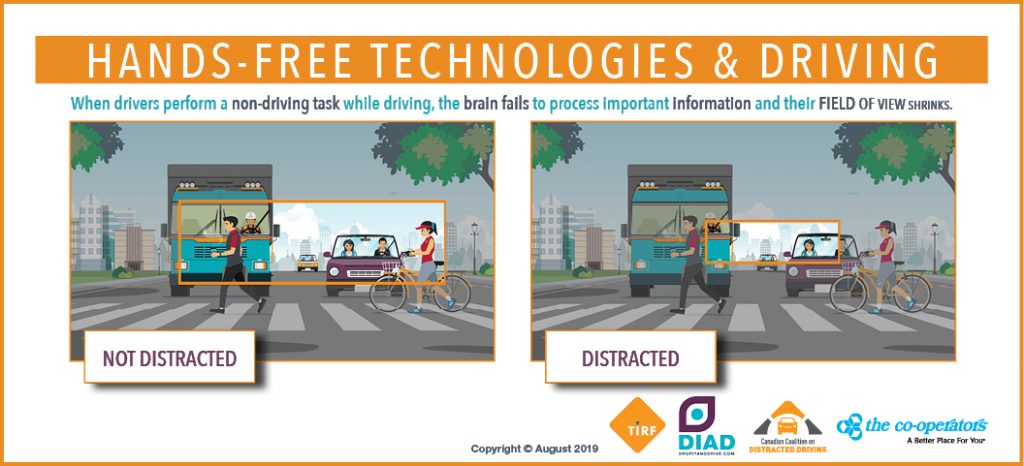Physical distancing and social isolation have changed our roadways immensely.
For the time being, slow commutes, congested rush hour traffic, construction zones and seemingly endless red lights have all but disappeared. Traffic volumes are at unprecedented lows and the aspirational goal of zero deaths and serious injuries due to road crashes feels like it might actually be within reach.
But although our roadways are emptier than ever witnessed in most of our lifetimes, the safety of essential workers who rely on them remains paramount. Canadians employed in health, security, transportation and other essential services sectors continue to use our roads every day while they work countless hours at maximum capacity to keep us safe and supplied with crucial goods and services.
In addition, all of us are feeling frustration and a sense of isolation right now doing our part to reduce the spread of COVID-19 by staying home. With limited trips to the grocery store and pharmacy as opportunities to escape the boredom, more Canadians are walking and cycling right now to avoid being trapped indoors for extended periods. Their safety on the roads is equally critical to avoid preventable crashes that tax our health care system.
Challenges during the pandemic
Efforts to stem the spread of the deadly COVID-19 virus have undeniably posed significant challenges. It has led to closures of school, businesses, restaurants, and a mass shutdown of a wide range of services. The rapid transition due to directives for employees to work from home have left employers and IT departments scrambling and created economic uncertainty for everyone. First responders and health professionals are spread thin, and governments are working overtime to put aid and relief packages in place and provide access to support Canadians during this difficult time.
Impact on road safety
While the challenges feel overwhelming, the potential to achieve progress in making roads safer should not be overlooked. Police agencies across Canada have reported fewer traffic violations, collisions, and casualties than usual. For example, York Regional Police reported a 29% decrease in impaired driving charges in March 2020 compared to March 2019. Similarly, Manitoba Public Insurance (MPI) reported a 25% reduction in collision claims in March 2020 compared to the average number of claims in March during 2017, 2018 and 2019.
For decades, police services have reported the fatal four factors in road fatalities: speed, non-use of seatbelts, impairment and distraction. Repeated messages to drivers have emphasized:
- slow down;
- wear seatbelts;
- avoid distractions; and,
- do not drive after consuming alcohol or drugs.
 |
 |
 |
 |
Now, more than ever, we need to heed those messages. While progress has been achieved, with an estimated 32% reduction in road fatalities between 2000 and 2016 (TIRF Fatality Database 2020), it has occurred slowly and with concerted effort.
More positively, the reduction in collisions on our roads in the past month suggests the goal of making our roads safer and achieving Vision Zero is indeed possible. However, the challenge will be to identify ways to sustain reductions in road crashes as restrictions are lifted and life returns to normal. This goal will require significant behaviour change and commitment by all Canadians.
The good news is we already know it’s possible. Across the country, people are handwashing, practising social and physical distancing, self-isolating as appropriate and adopting large scale changes in behaviour. There is widespread recognition that our actions and our choices put others at risk, and people are actively caring for others, particularly those who are vulnerable and at-risk.
This same level of awareness about the causes and consequences of road crashes is essential to eliminate deaths and serious injuries due to unsafe behaviours on the road. Perhaps more importantly, this pandemic has underscored the importance of safe roads as an essential element of any emergency preparedness strategy. Unsafe roads are a significant burden on our health care system, filling up emergency rooms and taking hospital beds daily. They also jeopardize the delivery and availability of essential goods, of greatest concern, perishable ones such as food. Moreover, essential workers injured on the road can deplete the workforce.
Building on the widespread adoption of healthy and safe practices emerging during this critical period, here are some other ways Canadians can contribute to risk-reduction and increase our level of emergency preparedness in the long-term.
Crash factors posing the greatest risk
Canadians can do their part to reduce road crashes and protect essential workers, vulnerable road users, and our health care system with a focus on the top four contributing factors posing the greatest risks during the pandemic:
- fatigue;
- distraction;
- speed; and,
- vulnerable road users.
Fatigue
Fatigued drivers on the road may be increasing as a result of long shifts by essential workers. Health care workers face incredible pressures and risks on the job. Employees responsible for our supply chain, from truck drivers to grocery story workers struggle with round the clock schedules and irate customers. In New Brunswick, a tired bulk store employee nearly drowned when she accidentally reversed her car off the ferry on the way home from work. Data from TIRF’s National Fatality Database reveal drivers dying in crashes between 3 am and 9 am are twice as likely to be fatigued as drivers dying in crashes at other times of the day.
Distraction

Distraction, which was a prevalent factor in road crashes prior to the pandemic, is likely on the rise with more Canadians experiencing mental health issues due to pressing concerns relating to loved ones, finances, and employment status. In addition, essential workers in sectors such as law enforcement, health care, and trucking are confronted daily with a risk of infection to themselves or their co-workers. This constellation of factors may mean drivers on the road are less engaged in the driving task, and just two seconds of eyes off the road can be fatal, particularly for vulnerable road users. Fatality data from pedestrian crashes shows distraction on the part of either the driver or pedestrian was a contributing factor in two of five crashes.
Speed
Since there is less traffic volume, some drivers are driving faster than usual. In addition, several police officers have either tested positive for COVID-19 or have self-isolated due to flu-like symptoms. As a consequence, there may be fewer police vehicles on the road to enforce traffic laws. Saanich Police impounded only two vehicles for excessive speeding in February of this year but impounded 16 vehicles for this offence in March. Similarly, Edmonton Police report significant increases in the number of speeding drivers in recent weeks, and York Police have seen a 64% increase in stunt driving (exceeding the speed limit by 50km/h) since March 1st, with 17 charges laid during Easter weekend. In just 7 days, Ottawa police seized 15 vehicles for stunt driving. Compared to March 2019, Toronto police reported stunt driving had increased 200% in March 2020.
Vulnerable road users
Lastly, drivers should be prepared to encounter more vulnerable road users, particularly pedestrians and cyclists, on our roads during the lockdown. Since schools are not in session, more children (and parents) may be walking and cycling on residential streets in the middle of the day. Unfortunately, social distancing may conflict with the rules of the road. For example, pedestrians may exercise social distancing by dispersing across the width of the road like the bad guys in a B-western.
Consequences for road crash victims
Ultimately, unsafe choices on the road have the potential to jeopardize the availability and quality of health care and essential goods when they are most needed. As a result of COVID-19, the new reality for road crash victims is troubling.
- It may take longer for police and paramedics to respond with commercial property crime increasing and many first responders contracting the virus themselves.
- Victims may wait longer for admission due to a shortage of health care workers.
- Hospital beds and ventilators may be unavailable, and seriously injured crash victims requiring a ventilator may be in a queue with COVID-19 victims.
What can we do?
Many of us have had our work, educational and recreational routines disrupted over the past several weeks. We may be acquainted with those who have suffered illness, lost work, or have been isolated from loved ones. Our first instinct is to help them in any way that we can. At present, our options are limited due to social and physical distancing, limits on group gatherings and directives to refrain from non-essential travel.
But we can, however, follow the medical injunction to do no harm by driving carefully and continuing to follow the rules of the road, irrespective of traffic volume. If we all exercise caution and consideration on the road, in the short-term, we can devote more health resources to COVID-19 patients. More importantly, in the long-term, we can ensure we are stronger, more resilient, and able to cope with emergency situations when they arise.
#MySafeRoadHome blog authors: Steve Brown is a research associate at the Traffic Injury Research Foundation (TIRF). He manages TIRF’s National Fatality Database and has co-authored many publications on road safety topics including distracted driving, alcohol and drug-impaired driving, commercial vehicles, and vulnerable road users. Robyn Robertson is the President & CEO of TIRF. She is a criminologist with 20 years of experience in road safety research, and the author of TIRF’s knowledge translation model. Robyn is well-versed in implementation strategies and operational practices to improve road safety programs across several sectors.
References:
Fatigue-related Fatal Collisions in Canada, 2000-2016, March 2020, Traffic Injury Research Foundation https://tirf.ca/Fatigue_Related_Fatal_Collisions_Canada_2000_2016
Distraction-Related Fatal Collisions, 2000-2016, September 2019, Traffic Injury Research Foundation https://tirf.ca/Distraction-Related_Fatal_Collisions_2000-2016
Sharing the Road: Pedestrians & Vehicles, January 2018, Traffic Injury Research Foundation https://tirf.ca/TIRFCAD18M
Pedestrians: What Do We Know?, Community-Based Toolkit for Road Safety Campaigns, 2015, Traffic Injury Research Foundation https://tirf.ca/projects/community-based-toolkit-road-safety-campaigns/
Government of Canada, Health, Coronavirus disease (COVID-19) https://www.canada.ca/en/public-health/services/diseases/coronavirus-disease-covid-19.html
Related topics:
 |
 |
 |
 |



